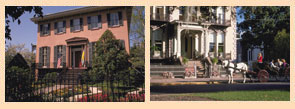|
QUEEN LODGING. Spacious and stylishly befitting a general of the American Revolution, The Nathanael Greene guestroom features a handsome antique leaf carved queen bed and matching oak furniture. The West Indies themed guestroom features soft oriental blues, coral walls and bath and tiger lily print. For restful leisure, a settee and chairs enhance the room's sitting area. The oversize bath features a claw foot tub, brass ring shower and antique oak chest vanity with sink.
Savor a palatial third level view of Savannah 's antebellum live oaks and magnolia trees of Charlton Street View, enjoyed through the floor-to-ceiling 12 foot ripped glass windows. Contact Savannah's family-friendly luxury inn
Tariff: $275
(click the photos for a larger view)
About Major General
Nathanael
Greene (1742-1786) Among America's Revolutionary officers, he was Chief of Staff and second only to George Washington. Together, they shared the distinction of being the only Continental generals that served throughout the entire War of American Independence.
In 1780 Washington gave Greene the arduous task of leading the feeble Revolutionary army of the South (1780-1783). In 1782 Greene came to the defense of Savannah when he sent General "Mad" Anthony Wayne to successfully push the British out of Savannah and into Charleston , thus ending British occupation of Georgia . Greene had willingly given much of his personal wealth to help support the war, even sacrificing his Rhode Island (Potowhommet, Warwick, Rhode Island) home. To thank him for his service during the war, the Georgia government gave Greene a plantation named Mulberry Grove, outside Savannah in Chatham County. He lived on the Mulberry Grove estate for less than a year, troubled by insecure finances; because his moral convictions barred the use of slave labor, the plantation did not become profitable. Greene died unexpectedly of sunstroke June 19, 1786 at the age of forty-four.
After Greene's death, a young Yale University graduate, Eli Whitney, came to Savannah to take a tutoring job. Whitney began working for Greene's widow, Catharine, and it was at Mulberry Grove that Whitney invented the cotton gin, the machine that revolutionized the production of cotton.
Greene's remains and those of his son, George Washington Greene, lie beneath a fifty-foot tall marble obelisk monument in Johnson Square in Savannah. Greene's funeral was a Christ Church on Johnson Square. The obelisk, designed by William Strickland, was completed in 1830. On 21 March 1825, the cornerstone was laid by the Marquis de Lafayette. Photo link and to learn more about Nathanael Green, click here. |













